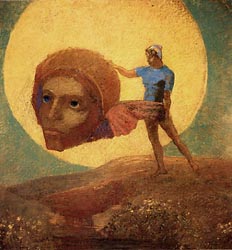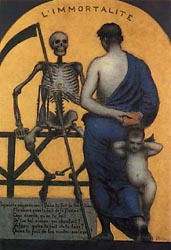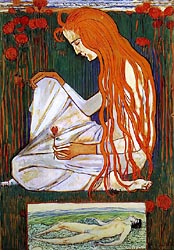|
Symbolism perhaps is more a philosophy about the content of art than
an actual style. It developed through a wide range of styles, from
variations of academic to the doorstep of abstraction . Symbolism is as much about evoking a
mood as it is about iconography. Many Symbolists preferred to
work as outsiders. Often the meaning
of their work was esoteric or even intentionally obscured. From this standpoint, it is
important to investigate each of these artists as individuals, not
just as
stellar points in a large constellation .
Most art historians identify the core of
the Symbolism movement as being in French speaking Europe. We therefore begin
our discussion with French artists.
| |
Odilon
Redon (1840-1916) ~
 Originally
a
graphic
artist and illustrator of early Symbolist
writing. In the 1890s, he turned from strange morbid charcoals to brightly
colored pastels and oils, instilled with deep mysticism . A visionary
artist, his body of work may be considered the quintessential
art of age of Symbolism . After meeting Gauguin in 1886, Redon
was to form a close relationship with Gauguin and became
affiliated with the Nabis. Originally
a
graphic
artist and illustrator of early Symbolist
writing. In the 1890s, he turned from strange morbid charcoals to brightly
colored pastels and oils, instilled with deep mysticism . A visionary
artist, his body of work may be considered the quintessential
art of age of Symbolism . After meeting Gauguin in 1886, Redon
was to form a close relationship with Gauguin and became
affiliated with the Nabis.
Biographical information can be found at
www.odilonredon.net/biography.html
Paul Gauguin
(1848-1903) ~ One of the major artists of latter part of the
19th Century, and a pioneer of Modernism . Helped to develop
the Cloisonnist style and subsequently Synthetism, which
emphasized a two dimensional perspective. Gauguin spent much
of his career as an artist pursuing folk art and the remnants
of primitive cultures. The
last decade and a half of his life was spent in French Polynesia
.
Eugene
Carriere (1849-1906) ~ Known for a distinct brown
monochromatic palette, he produced soulful, sometimes murky,
psychological studies.
Louis Welden Hawkins (1849-1910) ~
Born in Germany to a British father and Austrian baroness, he
studied in France where he would take citizenship.
Stylistically his work appears to be related to the
Pre-Raphaelites. father and Austrian baroness, he
studied in France where he would take citizenship.
Stylistically his work appears to be related to the
Pre-Raphaelites.
Alexandre Seon
(1855-1917) ~ In a style influenced by Puvis de Chavannes, he
explored mythological subject matter, such as Orpheus and the
Chimaera.
Alphonse
Osbert (1857-1939) ~ At first involved with Pointillism, he
became influenced by Puvis. Known for somewhat mysterious
evening and nocturnal landscapes.
Armand Point
(1861-1932) ~ Born in Algiers and influenced pre-Raphaelites,
he also admired Botticelli . Chose mythological and
allegorical subjects.
Maurice Denis
(1870-1943) ~ Member of the Nabi, he focused on Christian
imagery. He was important in establishing a two-dimensional
picture plane, and therefore impacted the avant-garde
movements in the early 20th century.
Edgar Maxence
(1871-1954) ~ Student of Gustav Moreau. Painted medieval
subjects in academic style.
Pablo Picasso (1881-1973) ~ During
his Blue Period (1901-04), the Spanish artist was deeply
affected by the suicide of his friend, Carlos Casegemas. His
paintings of this period are typically somber, in austere blue
tones. He often chose Symbolist subject matter. Some of his
work during the Rose Period (1904-06) that followed, also
showed Symbolist influences.
Gustave
Adolphe Mossa (1883-1971) ~ Most of his works were painted
after the turn of the Century. There are often uncanny or
bizarre elements in his art , which preludes the Surrealists.
|
Belgium was
the second important center associated with Symbolism .
| |
Felicien Rops (1833-1898) ~ Associated closely with Baudelaire
and other Symbolist writers. Known for caricature, etchings
and watercolors, he dealt mainly with erotic and Satanic
subjects.
Xavier Mellery (1845-1921) ~ Known for
his intimist works and as a muralist of allegorical subjects using traditional
techniques.
and as a muralist of allegorical subjects using traditional
techniques.
Fernand Khnopff (1858-1921) ~ Formed
friendships with Rossetti, Burne-Jones, Watts and other British
artists. He used a realistic style to explore the themes of
isolation and longing. Known for imagery of woman, including
that of Femmes Fatales, such as the Sphinx in The Caress.
Jan Toorop (1858-1924) ~ Dutch artist,
who lived in Belgium from 1882 to 1886 and became enamored with
Symbolism . He incorporated Javanese motifs in dynamic
compositions. Later he converted to Catholicism .
James Ensor (1860-1949) ~ He integrated grotesque masks and skeletons into
into complex allegories. A founding member of Les XX, he became
seclusive after the group's Salon rejected one of his paintings.
Jean Delville
(1867-1953) ~ Interested in occultism and esoteric spirituality,
he was influenced by Josephin Pelandan . He explores idealistic,
mythological and supernatural imagery.
Leon Spilliaert
(1881-1946) ~ From a younger generation of Symbolists, he used
simplified forms to evoke feelings of anxiety.
|
A number of artists from Germanic countries worked with Symbolist themes.
The styles used by these artists were generally derived from
academic naturalism .
| |
Hans Thoma (1839-1924) ~ He admired the artists of the German
Renaissance, and his art reflects his affinity to nature and a
simple idyllic life.
Ferdinand Hodler (1858-1918) ~ He developed a style known
 as
Parallelism, in which subjects or objects were arranged in
groupings suggestive of dance rituals. Used a highly detailed
Realism in much of his work, and explored Symbolists themes such
as death, fear, youth and ecstacy. as
Parallelism, in which subjects or objects were arranged in
groupings suggestive of dance rituals. Used a highly detailed
Realism in much of his work, and explored Symbolists themes such
as death, fear, youth and ecstacy.
Max Klingler (1857-1920) ~ His work contains imaginative dreamlike fantasy,
some complete with fetishes while others made references to
anxiety and death . Klinger's work was widely admired during his
time and was also to influence Giorgio de Chirico, Max Ernst,
and many of the Surrealist artists.
Maximilian Lenz
(1860-1948) ~ Painted pastoral allegories of women .
Gustav Klimt (1862-1918) ~ The Viennese
artist was influenced greatly by Symbolism, although also
interested in decorative motifs.
Franz von Stuck
(1863-1928) ~ Inspired by
Arnold Böcklin,
von Stuck drew on mythological subjects and developed the themes
of the femmes fatales.
Carlos Schwabe
(1877-1926) ~ Known for allegorical compositions involving Death
or the Afterlife. |
Symbolism spread throughout Europe during the latter decades of the
19th Century and also to the Americas.
| |
Elihu Vedder (1836-1923) American
~ He produced Symbolist works during the last half of the
19th century, with many important works being executed
during the peak period of the Symbolism movement.
Giovanni
Segantini (1858-1899) Italian ~
Jacek
Malczewski (1858-1929) Polish ~ Mined mythological
subject matter.
Arthur Bowen
Davies (1862-1928) American ~
John Duncan (1866-1945) Scottish
~ |
|
Symbolism developed a decade later in Russia than in Western Europe.
It made a more significant appearance in poetry than in the visual
arts. However, a number of artists are associated with it,
particularly in the first decade of the 20th Century.
| |
Mikhail Vrubel (1856-1910) ~ His unorthodox style developed
through study of medieval mosaics, and incorporated heavy
impasto and partial abstraction . His most well known works were
on the Prophet and Demon themes. Vrubel was a significant force
in the development of Russian Symbolism, and his work had
influence on the development of abstract art of Wassily
Kandinsky.
Mikhail
Vasil'evich Nesterov (1862-1942) ~ Interested in religious
themes, he is noted for an early work, Vision of Young
Bartholomew (1889-1890), viewed by some as the first
painting of Russian Symbolism .
Leon Baskt
(1866-1924) ~ Painted a number of visionary works at the turn of
the Century. He is most well known as a costume and set designer
for the Ballets Russes.
Constantin Somov (1869-1939) ~ Technically conventional, he
worked with a number of Symbolist themes.
Kuzma
Petrov-Vodkin
(1869-1939) ~ Influenced by Puvis de Chavannes and Vrubel, his
work incorporated neoclassical elements, later trending toward
Expressionism.
Nicholas Roerich
(1874-1947) ~ Together with his wife, Helena, they traveled
throughout Asia, investigating archaeological and cultural
sites. His art covers theosophical interests, many of them
on themes of mystic landscape, prophets and women's
spiritual importance. Most of them date from the 1920s and 30s,
several decades after the peak of Symbolist activity. |
The art of the era of Symbolism was to influence several artistic
movements in the 20th Century. A number of artists moved directly to
Expressionism, or one of the movements related to it. Several
artists, including Wassily Kandinsky and Kasimir Malevich moved
quickly to experiments in Abstraction . Symbolism influenced Gustav
Klimt and other artists associated with Art Nouveau. And in the late
1920s, the art of the Symbolists helped to found a new movement of
Surrealism .
Email:
dreams@tendreams.org
|